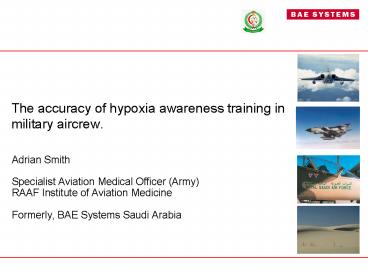The accuracy of hypoxia awareness training in military aircrew' - PowerPoint PPT Presentation
1 / 19
Title:
The accuracy of hypoxia awareness training in military aircrew'
Description:
Integral component of physiological training for ... Dyspnoea. 65. 59. Parasthesiae. 63. 49. Weakness. 57. 55. Feeling warm. 55. 59. Visual. 51. 54. Dim lights ... – PowerPoint PPT presentation
Number of Views:195
Avg rating:3.0/5.0
Title: The accuracy of hypoxia awareness training in military aircrew'
1
The accuracy of hypoxia awareness training in
military aircrew.
- Adrian Smith
- Specialist Aviation Medical Officer (Army)
- RAAF Institute of Aviation Medicine
- Formerly, BAE Systems Saudi Arabia
2
Symptoms of hypoxia
- Hypoxia symptoms vary from person to person
- Range of symptoms experienced
- Severity of individual symptoms and
- Order in which symptoms appear.
- Believed to be relatively stable over time
(Pickard 2002 Gradwell 2005). - Each person has a hypoxia signature.
3
Hypoxia awareness training
- Integral component of physiological training for
military (and civil) aircrew. - Allows aircrew to experience hypoxia in a
controlled training environment. - Enables aircrew to recognise their hypoxia
signature early enough to react within their
time of useful consciousness.
4
Is hypoxia awareness training effective?
- Hypoxia incidents in the Australian Defence
Force, 76 of aircrew recognised their symptoms.
(Cable 2003) - 31 of military aircrew who experienced hypoxia
during accidental loss of cabin pressure
recognised their symptoms. (Files et al 2005) - High rate of recognition of hypoxia attributed to
effectiveness of hypoxia awareness training. - Hypoxia-naïve aircrew more likely to lose
consciousness during hypoxia than hypoxia-trained
aircrew, presumably due to delayed recognition of
hypoxia. (Island Fraley 1993, cited in Cable
2003)
5
But, on the other hand
- 25 - 70 of aircrew who have experienced
in-flight hypoxia have not recognised hypoxia. - Explosive decompression in a commercial aircraft
(bang, misting) - Cabin oxygen masks deployed
- Captain elected to NOT use oxygen mask
- Co-pilot despite feeling light-headed held
the oxygen mask to his face as needed. (AAIU
Report 2001/0014) - Explosive decompression failure of rear
pressure-bulkhead. - FE queried Captain 4 times about need to don
oxygen masks. - Loss of cabin pressure, cabin oxygen masks
dropped. - Captain Theoretically, we should be on oxygen
(AAIU Report 2001/0018)
6
But, on the other hand
- 1999 commercial flight with two former-RAF
pilots. - Pilot became hypoxic and fell unconscious.
- Neither crew fully appreciated the nature of
hypoxia or urgency to respond. - Even those crew who have had the benefit of
training in a hypobaric chamber in the past may
not be immune from failing to recognise the
importance of immediate action. - 2001 civil-register RAAF-operated Super King
Air failed to pressurise - Three military aircrew, all hypoxia experienced.
- The pilot and passengers had all undertaken
regular hypoxia training. Despite this they
did not identify the onset of symptoms of
hypoxia until one person became unconscious.
7
For hypoxia awareness training to be effective
- Aircrew must remember their symptoms of hypoxia
- Amnesia, confusion, and drowsiness during acute
hypoxia - Remember these symptoms until next refresher
training (3-5 years) - Natural decay of non-refreshed memory
- The symptoms aircrew remember must reflect
their hypoxia signature. - Classroom knowledge overlaying imprecise memory
of true symptoms. - Aircrew must
- recognise symptoms as being hypoxia
- appreciate the significance of in-flight hypoxia
- carry out immediate corrective action.
8
Aims
9
Method
- Hypoxia awareness (refresher) training.
- 22 hypoxia symptoms, completed twice
- Before the hypoxia lecture (What symptoms do you
remember) - After hypoxia awareness training (What symptoms
did you experience). - Analyses
- Distribution of hypoxia symptoms
- Level of agreement
- the symptoms remembered and those experienced
(overall) - 5 dominant symptoms on each survey
10
Results
- 58 consecutive students - 85 effective response
rate (n49) - All exhibited signs of hypoxic impairment SpO2
60-65 - 53 Pilots
- 47 Loadmasters, flight engineers, mission
specialist crew - 33.7 years old
- 2048 hrs flying experience
11
Symptoms of hypoxia - collective
12
Level of agreement memory and experience?
16 symptoms
13 symptoms
13
Did they experience the symptoms they remembered?
14
Did they remember the symptoms they experienced?
15
Recency of training
N10
N15
p 0.36
16
Age
p 0.25
17
Recency of training
p 0.16
18
Summary
- High level of agreement between
- Symptoms remembered and those actually
experienced and - Symptoms experienced and those remembered from 3
years earlier. - Recognition of hypoxia signature remains high up
to 3 years, and is unaffected by age. - Emphasis of hypoxia awareness training
- Be aware of symptoms.
- Recognise hypoxia signature, and appreciate its
significance. - Decide to act.
- Hypoxia awareness training an effective and
valuable tool for demonstrating hypoxia
signatures to aircrew.
19
Questions
- adrian.smith14_at_defence.gov.au
- Smith, A. M. (2008). Hypoxia symptoms in military
aircrew long-term recall vs acute experience in
training. Aviation, Space, and Environmental
Medicine, 79, 54-57.































